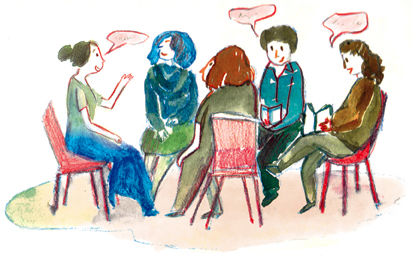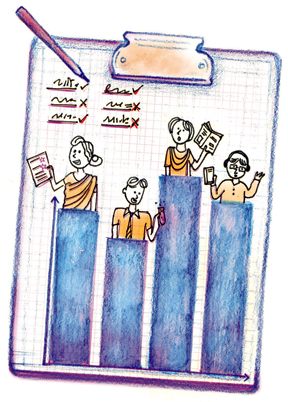Surabhi Agarwal
Art has an undefined power. It may not fit into a set of rules, but it can still be brilliant to its audience. Teaching is one such powerful art. It is a creative force and teachers have their own special approach of exploring it. Good lessons have a lasting impact on the students. These lessons are remembered years after being taught and it shapes the students in inexplicable ways. Just like a song that is hummed years after being listened to. But unfortunately, teacher evaluations are mechanical and they ignore the creative side of teaching.
The purpose of evaluating professionals is to help them develop their skills. In the case of teaching, these evaluations should inspire teachers to revisit their practises. All conducive learning spaces are held together by such enabled facilitators. But sometimes, such efforts limit the teachers instead of empowering them. It’s a courageous task to actively engage 20-40 young minds. Teachers let go of their inhibitions and stage fright. They muster their knowledge, experience and courage to get the topic across. Right in the middle of this intricate process, observers enter to evaluate their skills. They provide inputs on all that went wrong and how it can be improved. “I don’t believe in observing just a lesson… the objective of teaching and learning is not to do a five-star lesson for 40 minutes, but for the learning to be robust and for it to last,” says Aishwarya M, who has worked as a middle school teacher in government-aided private schools.
So, how do schools measure the capabilities of their most crucial employees – the teachers? It is important to note that a school is a people centric organization. Students, parents, teachers, administrators, and school leaders (principal, vice-principals, heads of departments, academic coordinators) are all cogs in the wheel who keep the ‘teaching-learning’ cycle going. With complex interactions at every level, what practices do schools adopt to evaluate their teachers?

In most government schools and affordable private schools, any due process around teacher evaluations is non-existent. The school leaders may be aware of their team’s capabilities through student and parent interaction. But these observations are informal and inconsequential. Government-aided private schools and private schools may have mechanisms to annually monitor and evaluate performance.
It is interesting to note that schools having a dedicated task force for professional development, hold a more liberal view of a ‘teacher’s performance’. They would go beyond exam results and look for an engaged class, inquisitive students and retention of knowledge.
If present, the commonly used methods for teacher evaluations are as follows.
• Classroom observations. This includes visiting a classroom during an ongoing lesson. Conducted by school leaders, these observations are followed by feedback in the form of rubrics or discussions.
• Form based appraisals. This involves filling forms to rate performance on a set of defined standards. Such appraisals are evidence based and look for measurable traits like adherence to plans, assessment results, absenteeism, etc.
• Peer reviews. This involves shared planning, collaborative observations, and group discussions through which teachers get an understanding of the most useful pedagogical practises.

Apart from this, most teachers admit that they ask their students for review. “Who is the best judge? The students. If you’re able to engage with the students, they are enjoying your class, at the same time they are learning something new. But those things will not come to their assessment at all,” says Arunima Sinha, who teaches English in a residential school.
None of these methods can flawlessly evaluate the nuances of being in a classroom. However, observations followed by feedback comes close to having a more robust view of the teaching-learning process. It is based around having meaningful conversations between teachers and mentors. Still, many teachers admit that they usually don’t take feedback seriously. “I have put in a lot of work (for my lesson). So, if I am making a statement, making a move in the classroom, none of what I do is random. None of what I do just happens for no reason. Everything has been thought over. There is work, effort, reading, evidence and experience behind it. So, to discount that and to just come and give one superficial observation, and not to consider what’s gone behind it and be curious about my process, I have not found it useful,” recalls Aishwarya. Teachers find the feedback to be ineffective because it is
• not objective. It does not help them groom their skills.
• extrapolative. It makes an unfair and generalized judgment about their overall skills by analyzing a small sample.
• negatively framed. It is critical and disrespectful towards the teacher’s own process.
• person-dependent. It is coloured by the observers’ personal equation with the teacher.
• without context. It is not customized to the teacher’s experience, grade and subject.
• not confidential. It gets shared with students or peers which leads to unhealthy comparisons and competitiveness.
• an eyewash. It is lensed because it impacts their probations, payrolls, and promotions.
In spite of the resources that school leaders put into the process of teacher evaluations, they don’t see significant changes in their staff’s practises. Teachers themselves feel that it is neither a fair use of their time, nor does it help them conduct better lessons. Neha Dubey has extensive experience of leading school teams and she points out that the reason lies in the unaccounted nature of their non-teaching duties. They handle administrative work, data entries, school events, and parent queries, to name a few. “It just goes on… I don’t see that ending anywhere. And then they (teachers) are expected to be on their toes all the time. So, who is thinking about their conservation of energy… nobody is! Unless that is corrected, we will not really be able to make a difference. And that is why I see a lot of talented people… they burn out and then they quit,” she says.
In this context, the role of the school leaders is of utmost importance as they are the only people who can help teachers tap their full potential. Some suggestions from teachers to their leaders are summarized below.
• Adapt the appraisals – Instead of a one-size-fits-all questionnaire, ask genuine and non-coaxing questions that help teachers recall their classroom experiences. Hold empathetic, non-interruptive conversations that focus on the unique challenges of student learning.
• Train the leadership – Build a trustworthy and accountable leadership team that is cognizant of the sensitivity of their job. Leverage the experience of senior teachers and build time for them to take up trainings.
• Ensure constructive feedback – Provide appreciative, solution centric, documented, and personalized feedback. Unthoughtful criticism may have the opposite effect, wherein teachers actively try not to let it affect them. A single teacher sparing a few months leads to damaging the classroom for that period of time. If given correctly, most of the teachers will look forward to the feedback to groom their own skills.
• Be approachable – Create time for teachers to have safe conversations with the people overlooking their work. On an occasional off-day, relate to their experience instead of aligning them with ‘one’ way of running a classroom. Enunciate the school’s expectations and define the criteria for their success.
• Involve teachers in decision-making – Give teachers a voice in the decisions that directly impact their work. They are an overburdened and an underpaid human resource. With edtech solutions (products/projects/pedagogy) being force fed to schools, it is all the more important to have trained and confident teachers who are convinced about these solutions. Forced solutions are bound to produce friction and the desired results are difficult to achieve.
• Leverage Teacher Professional Development (TPD) – Arrange meaningful TPD sessions that are personalized to the team’s requirement and allows them to exercise choice. Teaching is a creative skill that needs to be updated with evolving times. It is important to get trainable people on board who are willing to learn, unlearn, and relearn new skills to keep pace with the curriculum that is relevant to their students.
• Build teaching communities – Create intra and inter school teaching groups. Encourage cross observations and sharing of inputs that will help democratize knowledge.
Based on the school’s vision, the leaders must define minimal traits they look for in their teachers. Beyond that, give them the choice to carry the school’s vision in their own artistic way.
A classroom is a close-knit and vibrant entity. It is made with all the flaws and beauty of human nature. A lot of what teachers overcome is invisible to an untrained eye. Therefore, teachers must be treated as creative professionals who bring in their own agency, imagination and solutions to their classroom. Assessing the art of teaching must be a holistic, conversation driven and empathetic process built on mutual trust.
The author is an ex-Teach for India fellow and a curriculum specialist who has designed pedagogical strategies for languages and STEM. She can be reached at surabhi.r.agarwal@gmail.com.
Related Article
